GIGABYTE Z87X-OC Review: Overclocking Oriented Orange at $200
by Ian Cutress on October 11, 2013 10:00 AM EST- Posted in
- Motherboards
- Intel
- Gigabyte
- Z87
Rightmark Audio Analyzer 6.2.5
In part due to reader requests, we are pleased to include Rightmark Audio Analyzer results in our benchmark suite. The premise behind Rightmark:AA is to test the input and output of the audio system to determine noise levels, range, harmonic distortion, stereo crosstalk and so forth. Rightmark:AA should indicate how well the sound system is built and isolated from electrical interference (either internally or externally). For this test we connect the Line Out to the Line In using a short six inch 3.5mm to 3.5mm high-quality jack, turn the OS speaker volume to 100%, and run the Rightmark default test suite at 192 kHz, 24-bit. The OS is tuned to 192 kHz/24-bit input and output, and the Line-In volume is adjusted until we have the best RMAA value in the mini-pretest. We look specifically at the Dynamic Range of the audio codec used on board, as well as the Total Harmonic Distortion + Noise.
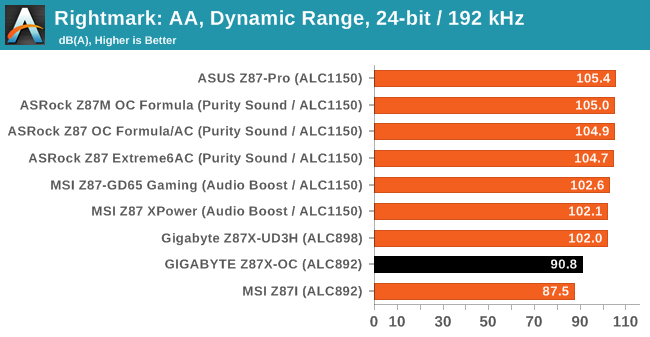
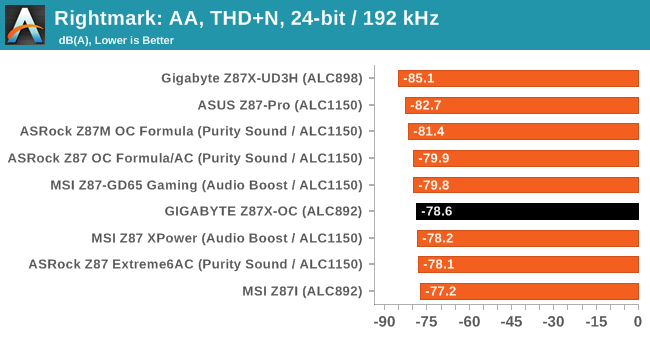
While the ALC892 falters in dynamic range, the harmonic distortion of GIGABYTE solutions seems to be on the preferable side, especially when their ALC892 and ALC898 solutions score above other ALC1150s.
USB Backup
For this benchmark, we run CrystalDiskMark to determine the ideal sequential read and write speeds for the USB port using our 240 GB OCZ Vertex3 SSD with a SATA 6 Gbps to USB 3.0 converter. Then we transfer a set size of files from the SSD to the USB drive using DiskBench, which monitors the time taken to transfer. The files transferred are a 1.52 GB set of 2867 files across 320 folders – 95% of these files are small typical website files, and the rest (90% of the size) are the videos used in the WinRAR test. In an update to pre-Z87 testing, we also run MaxCPU to load up one of the threads during the test which improves general performance up to 15% by causing all the internal pathways to run at full speed.
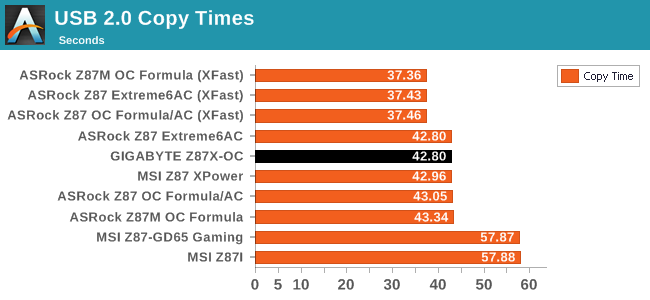
Nothing out of the ordinary in USB 2.0 - the system scores similar to other non-boosted Z87 motherboards and does not have the issue that plagues certain MSI models.
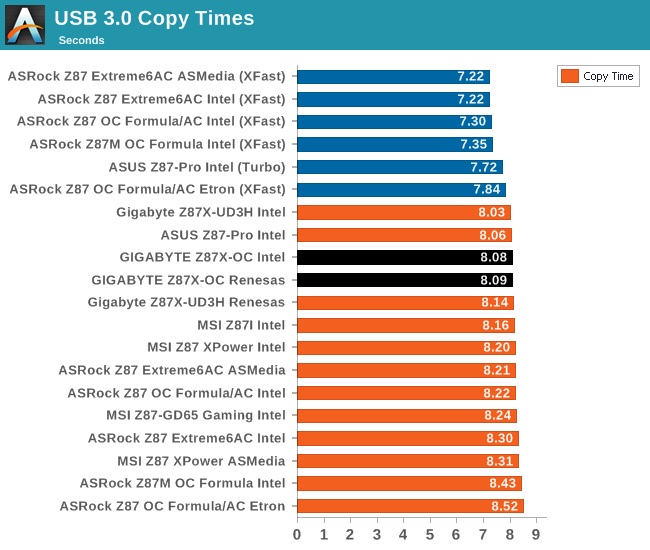
Similarly with USB 3.0, the Z87X-OC, on both the Renesas and Intel controllers, performs well.
DPC Latency
Deferred Procedure Call latency is a way in which Windows handles interrupt servicing. In order to wait for a processor to acknowledge the request, the system will queue all interrupt requests by priority. Critical interrupts will be handled as soon as possible, whereas lesser priority requests, such as audio, will be further down the line. So if the audio device requires data, it will have to wait until the request is processed before the buffer is filled. If the device drivers of higher priority components in a system are poorly implemented, this can cause delays in request scheduling and process time, resulting in an empty audio buffer – this leads to characteristic audible pauses, pops and clicks. Having a bigger buffer and correctly implemented system drivers obviously helps in this regard. The DPC latency checker measures how much time is processing DPCs from driver invocation – the lower the value will result in better audio transfer at smaller buffer sizes. Results are measured in microseconds and taken as the peak latency while cycling through a series of short HD videos - less than 500 microseconds usually gets the green light, but the lower the better.
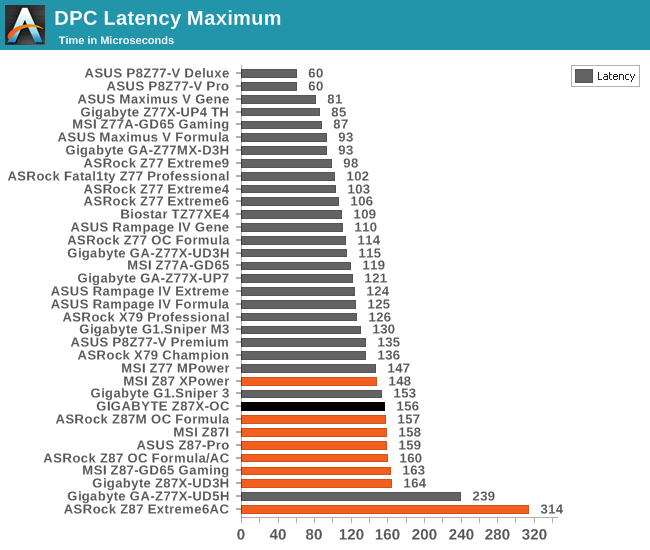
Once again our peak DPC Latency test for a Z87 motherboard performs around the 150 microsecond mark. For the most part, the Z87X-OC was under 100 microseconds easily, however as we record the worst case scenario, this seems to peak at ~150 for any Z87 unless there is a BIOS issue.










23 Comments
View All Comments
IanCutress - Friday, October 11, 2013 - link
With the last few generations, it's always been about 'have you got a good chip?'. A good OC chip of Ivy (or Sandy) has always been better than a bad chip this gen, and sometimes there isn't the certainty of getting a good chip this time around. That means the only jumps where it makes sense is when a bad chip in the newest gen beats your good chip. Each gen seems to give a 200-500 MHz IPC advantage (at 4GHz) depending on the CPU benchmark test (less in gaming), and you need to decide when that jump takes place if you're on the cutting edge of performance.But if you had a bad chip/ran at stock, then perhaps every two generations it makes sense to upgrade due to the IPC benefits. There are some pretty awesome low power chips this generation for example.
iTzSnypah - Friday, October 11, 2013 - link
I guarantee you that setting your Uncore to x34/35 will make the chip require less Vcore to be stable at any frequency.DanNeely - Friday, October 11, 2013 - link
Another use for the on board USB2 ports would be a thumbdrive to store bitlocker full disk encryption keys since the board doesn't appear to include a TPM keystore. Using an external USB port for that strikes me as mildly dangerous since it would be easy for someone to accidentally borrow the drive for something else.Nirvanaosc - Friday, October 11, 2013 - link
Hi everyone,I've read a lot of reviews already and most of the time I feel that the given motherboard is not enough or too much for what I need.
What would be the best for a day-to-day PC with a 4670K OCed and single GPU? This motherboard looks impressive but I think it's overkill for that purpose.
just4U - Monday, October 14, 2013 - link
It's different for everyone.. For me right now it's the G1 Sniper M5. While Anandtech has mentioned it I don't believe they've reviewed one yet.. I like the onboard sound/lan options which are not the generic Realtek stuff and tend to go matx.. but still want a board that's a cut above.. Asus also makes something similar in their Maximus6 Gene.vailr - Friday, October 11, 2013 - link
Did your board include the updated version Intel C2 chipset? And: did Gigabyte change the board version to 1.1, in order to indicate the presence of the updated C2 chipset? The review's photo shows board version 1.0.HardwareDufus - Saturday, October 12, 2013 - link
I really appreciate the inclusión of 2 HDMI ports instead of a DVI. I would love to find a Premium mini-ITX board that offered 2 HDMI ports.samsp99 - Saturday, October 12, 2013 - link
Does the audio codec really make that much of a difference these days? An old receiver for d2a, or a headphone amp like a fiio e10 solve that deficiency pretty well.CatheyBarrett48 - Saturday, October 12, 2013 - link
First time i trusted an online job add and managed to make 90$ in 5 hours... ℰxit35.comgenzai - Saturday, October 12, 2013 - link
I'm not sure what you mean by "for some reason only two of the chipset USB 3.0 ports are used. There are two USB 3.0 hubs for another eight USB 3.0 ports, and it seems..."If they used all 6 PCH SATA ports and put the FlexIO into PCIe, then they have 4 USB 3.0 ports to work with. 2 of those are routed directly to a FP header and then the other 2 each go to 4 port hubs to give another FP header and 6 rear ports. Seems perfectly logical and maximizes the available configuration.
g\